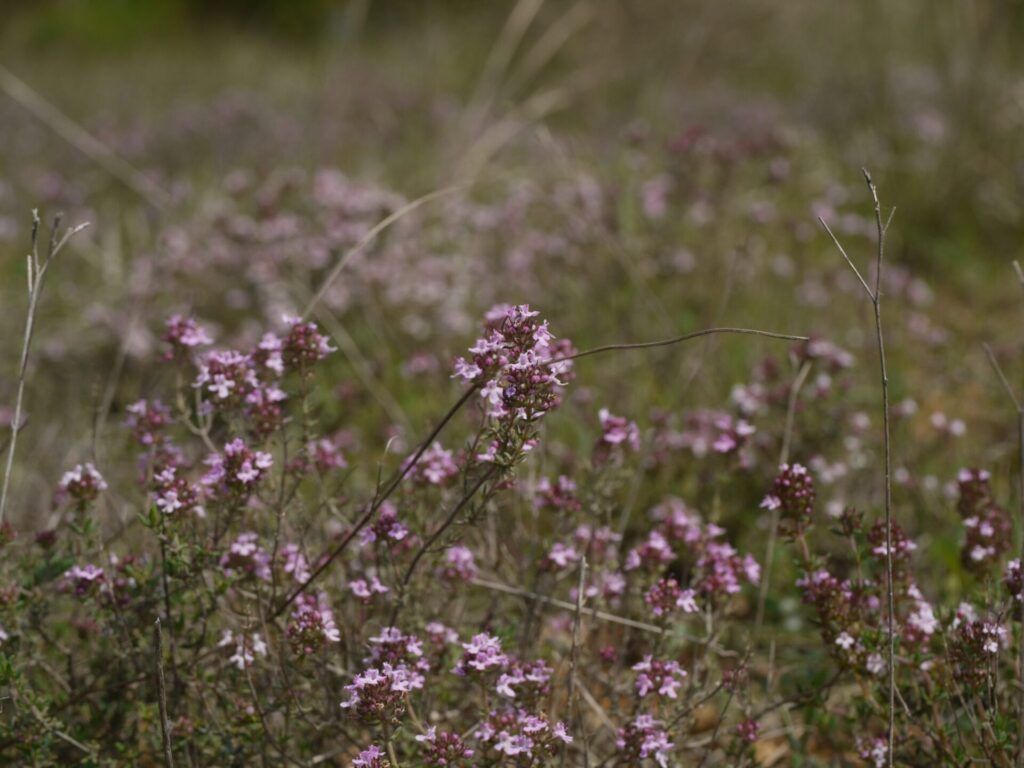Thyme
Thymus vulgaris L.
Lamiaceae
The Latin name Thymus comes from the Greek Thymos, which means “smoke” or even from Thio which means “I perfume”. This reminds us of the aromatic nature of many thymes, including the common thyme, which was used as incense.
The botanical genus Thymus is present mainly on the Mediterranean rim and contains nearly 350 species which are for the most sub-shrubs.
Some species are widely distributed, such as thyme “serpolet”, Thymus serpyllum, present from Scandinavia to northern Africa, or Thymus capitatus, seen from southern Spain to Turkey. Others grow only on restricted areas such as the thyme of Granada, Thymus granatensis, which is present only in the mountainous massifs of Andalusia.
En France, c’est surtout le thym commun, Thymus vulgaris, qui est employé, aussi bien en cuisine qu’en médecine naturelle. Il est abondant dans un grand quart sud-est où il pousse dans les lieux secs et les zones rocailleuses.
C’est la « farigoule » des provençaux, symbole de la région et chéri par Marcel Pagnol : « Je quittai le chemin, je courus toucher leurs petites feuilles. Un parfum puissant s’éleva comme un nuage, et m’enveloppa tout entier. C’était une odeur inconnue, une odeur sombre et soutenue, qui s’épanouit dans ma tête et pénétra jusqu’à mon cœur. C’était le thym, qui pousse au gravier des garrigues », La gloire de mon père.
In nature there are very various smells of common thyme, as there are different chemical types depending on the molecule dominant in the essential oil: linalol (sweet, flower or fruit like smell), thymol (pungent and powerful smell), etc.
These thymes will have different odors and tastes, even if they look the same. In the kitchen, Provençal thyme is widely used for its powerful and pungent aromatic taste that is suitable for all salted preparations, meat, fish or vegetables. This Provence thyme will soon benefit from a PGI (Protected Geographical Indication) in order to enhance this heritage. The other types of thyme bring different aromatic notes that are suitable for desserts and pastries (see recipe).
In herbalism, thyme is a major plant for all infectious states. The essential oil contained in the plant is indeed a powerful antibacterial. But thyme also acts at other levels which allows to have a global action on the organism and not just on the agent responsible for the disease. This plant acts on three levels:
- Upstream: it stimulates the immunity and corrects the ground that allowed the infection to settle.
- On the disease itself: it fights bacteria and viruses.
- Downstream: Thyme is a tonic that will promote recovery and accelerate healing by restoring energy to the body.
It is a perfect example of what is sought after in phytotherapy, hence its frequent use.
Crème brûlée with thyme
- 4 egg yolks
- 40 cl whole cream
- 4 tbsp honey
- 1 bunch fresh thyme
- Sugar
Préchauffer le four à 120° pendant 10 min.
Porter à frémissement la crème avec le thym
Coupez le feu puis et laisser infuser 15 minutes, filtrer au chinois
Mélanger au fouet les jaunes d’œufs et les 4 cuillères à soupe de miel.
Incorporer progressivement la crème aux œufs battus avec le miel.
Verser la crème obtenue dans des ramequins et enfourner au bain marie 1 H 30 à 110 °. La texture doit être prise mais tremblante.
Laissez refroidir et réservez au frais pendant 3 heures.
Saupoudrez le sucre sur les crèmes et flamber sous le grill de votre four.
